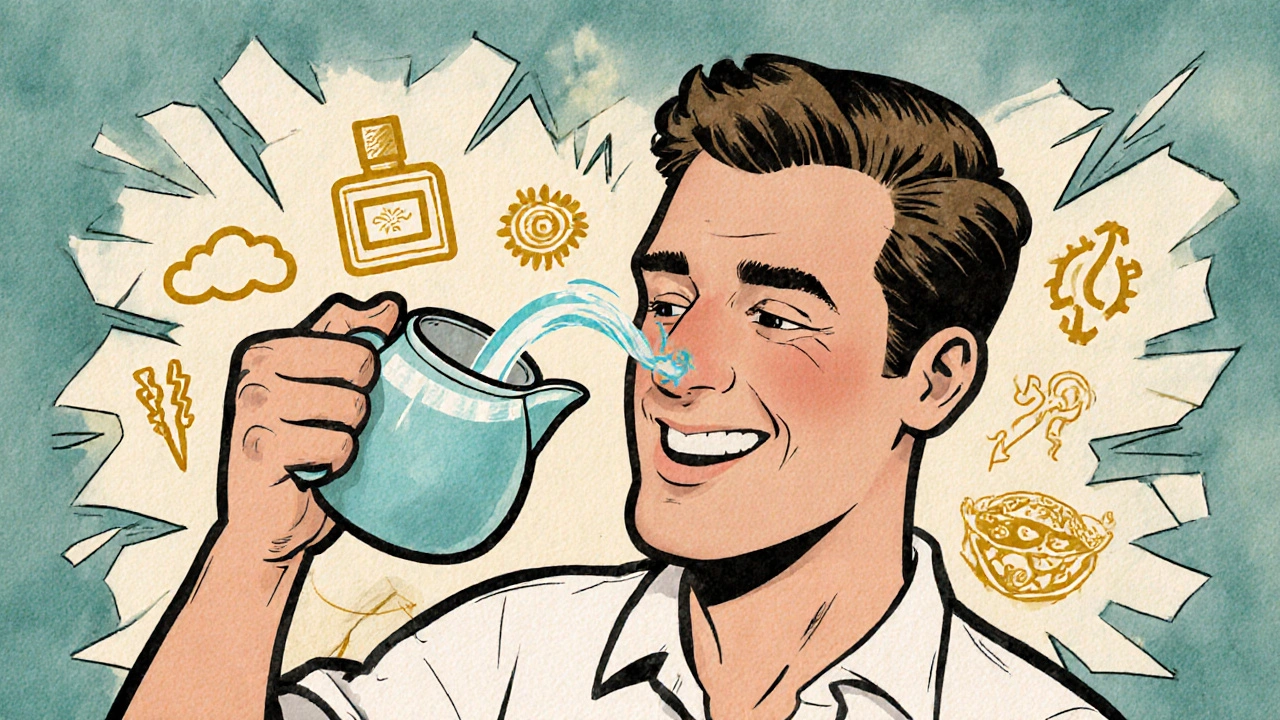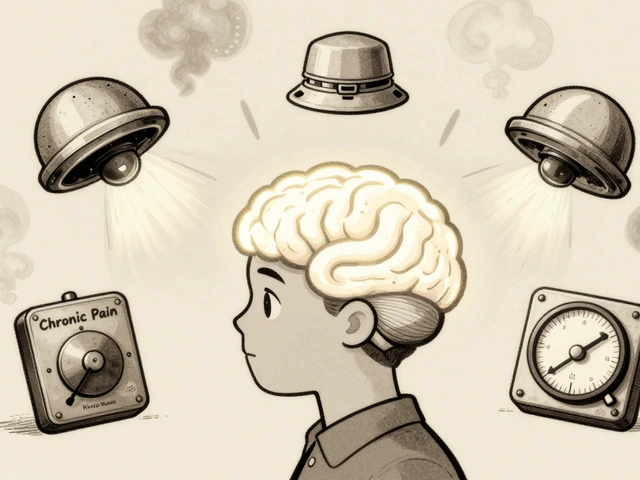Ever had a runny nose, stuffy nose, or constant sneezing - but your allergy test came back negative? You’re not alone. More than 1 in 5 adults in Western countries deal with nonallergic rhinitis, a chronic condition that mimics allergies but has nothing to do with pollen, dust mites, or pet dander. Unlike allergic rhinitis, which flares up when your immune system overreacts to harmless substances, nonallergic rhinitis is triggered by things like cold air, strong smells, spicy food, or even changes in the weather. And because it doesn’t show up on standard allergy tests, it’s often misdiagnosed - leaving people stuck with ineffective treatments and endless frustration.
What Exactly Is Nonallergic Rhinitis?
Nonallergic rhinitis is inflammation of the nasal lining that happens without an allergic reaction. It’s not caused by IgE antibodies, which are the body’s usual suspects in allergies. Instead, it’s a problem with how your nasal blood vessels and nerves behave. Think of it like a thermostat gone wrong: your nose gets overly sensitive to things that shouldn’t bother it - like walking into a cold room, eating hot soup, or being near perfume. There are at least eight subtypes, but the most common is vasomotor rhinitis, which makes up 60-70% of cases. This subtype is driven by an imbalance in your autonomic nervous system - the part that controls things like heart rate and digestion without you thinking about it. When the parasympathetic nerves get too active and the sympathetic ones get too quiet, your nasal blood vessels swell up, mucus flows freely, and you end up with a dripping or blocked nose. Another subtype, NARES (nonallergic rhinitis with eosinophilia), looks like an allergy under the microscope because it has eosinophils in nasal secretions - but still tests negative for allergies. Then there’s drug-induced rhinitis, often caused by blood pressure meds like ACE inhibitors or beta-blockers. And gustatory rhinitis, which hits after you eat - especially spicy or hot foods. Pregnant women are also at higher risk, with 20-30% developing hormonal rhinitis during pregnancy.What Triggers Nonallergic Rhinitis? (The Real Culprits)
The triggers for nonallergic rhinitis are everywhere - and they’re not always obvious. Here’s what actually sets off symptoms, backed by clinical studies:- Temperature shifts: A drop or rise of more than 5°C (9°F) within an hour can trigger symptoms. Walking outside on a chilly morning or stepping into a heated store can do it.
- Humidity changes: A swing of 20% or more in relative humidity - say, from dry air in an airplane to humid air in a bathroom - can cause nasal swelling.
- Chemical irritants: Perfumes, paint fumes, cigarette smoke, and wildfire smoke are major offenders. Even low levels - like 0.1 parts per million of perfume - can provoke a reaction.
- Food and drink: Spicy foods with capsaicin (think chili peppers) trigger rhinorrhea in many people. Alcohol, even in small amounts (blood alcohol above 0.02%), can cause nasal congestion and runny nose.
- Medications: ACE inhibitors (like lisinopril) cause symptoms in 20% of users. Beta-blockers (like metoprolol) affect 15%. NSAIDs like ibuprofen can also worsen it in 10-15% of people.
- Workplace exposures: Flour dust, latex particles, and chemical vapors in cleaning products or industrial settings can lead to occupational rhinitis, with symptoms worsening during the workweek.
- Hormonal changes: Pregnancy, puberty, and thyroid disorders can all trigger or worsen symptoms.
One key insight from recent research: TRPV1 channels - tiny sensors in your nasal lining - are overactive in people with nonallergic rhinitis. These channels react to heat, chemicals, and irritants. In patients, they’re 3.2 times more abundant than in healthy people. That’s why even mild triggers feel overwhelming.
How Is It Diagnosed?
There’s no single test for nonallergic rhinitis. Diagnosis is a process of elimination. Your doctor will start by ruling out allergies with a skin prick test or blood test for IgE antibodies. If those come back negative - and your symptoms have lasted more than 3 months - you likely have nonallergic rhinitis. Nasal endoscopy might be used to check for structural issues like a deviated septum. Nasal cytology (examining mucus under a microscope) can help too: if you see mostly neutrophils instead of eosinophils, that points away from allergies. But here’s the problem: only 25-30% of primary care doctors correctly identify it. The rest often misdiagnose it as allergic rhinitis - which means patients get antihistamines that don’t work, or even allergen shots that do nothing. A 2023 Reddit survey of over 1,200 people found that 65% were initially told they had allergies, and it took an average of 3.2 years to get the right diagnosis.
Effective Management Strategies That Actually Work
The good news? You don’t need to live with constant sniffles. Here’s what works - based on clinical evidence, not guesswork.1. Avoid Your Triggers
This sounds simple, but it’s the most powerful first step. Studies show:- Using a HEPA filter at home reduces symptoms by 35-40%.
- Avoiding strong scents (perfumes, air fresheners, cleaning products) cuts symptoms by 25-30%.
- For gustatory rhinitis, avoiding very spicy or hot foods reduces runny nose by 40-50%.
Keep a daily log: note temperature, humidity, what you ate, where you were, and your symptoms. After 4-6 weeks, patterns emerge. You might realize your nose runs every time you leave your heated house into the cold - or after coffee in the morning.
2. Nasal Saline Irrigation
This is one of the most underused, yet highly effective tools. Rinsing your nose with salt water - either isotonic (0.9%) or hypertonic (3%) - clears irritants, reduces swelling, and improves mucus flow.- 60-70% of users report significant relief.
- Twice-daily use is 45% more effective than once daily.
- Many users report improved sense of smell and reduced need for medications.
Use a neti pot, squeeze bottle, or nasal spray. Make sure to use distilled, sterile, or previously boiled water. Tap water can carry dangerous microbes.
3. Ipratropium Bromide Nasal Spray
If your main symptom is a runny nose, this is your best bet. Ipratropium (brand name Atrovent) blocks the nerve signals that cause excess mucus. It doesn’t help with congestion, but it stops the drip.- Reduces rhinorrhea by 70-80% within 48 hours.
- Works fast - often within hours.
- Not addictive, no rebound effect.
It’s a nasal spray, used once or twice a day. Side effects are mild: dry nose, bitter taste, or occasional nosebleeds. A new 0.03% formulation (approved in March 2023) is even better - 20% more effective with fewer side effects.
4. Intranasal Corticosteroids
Fluticasone (Flonase), mometasone (Nasonex), and budesonide (Rhinocort) reduce inflammation and swelling. They’re the go-to for moderate to severe cases.- Reduce overall symptoms by 50-60%.
- Take 2-4 weeks to reach full effect - don’t give up after a few days.
- May cause nosebleeds in 15-20% of users.
These are not antihistamines. They’re steroids applied directly to the nose - minimal absorption into the bloodstream. They’re safe for long-term use.
5. Azelastine Nasal Spray
This antihistamine nasal spray is less effective for nonallergic rhinitis than for allergic rhinitis - but still helps about 30-40% of people. It works fast (within 1-2 hours) and can be used with saline or corticosteroids.Downside: a bitter taste in the mouth is common (reported by 30-40% of users). Spit out excess spray instead of swallowing it.
What Doesn’t Work - And Why
Many people waste time and money on treatments that don’t help:- Oral antihistamines (like loratadine or cetirizine): These block histamine, which isn’t the main driver in nonallergic rhinitis. They offer little to no benefit.
- Decongestant sprays (like oxymetazoline): These give quick relief - but overuse leads to rhinitis medicamentosa, a rebound effect where your nose gets worse the more you use it. If you’ve been using these daily for more than 3-5 days, you may have this condition.
- Allergy shots: If you don’t have allergies, immunotherapy won’t help. It’s a waste of time and money.
Stopping decongestant sprays is hard - but doable. Use a corticosteroid spray during the 7-10 day withdrawal period. Most people see improvement within 2 weeks. Mayo Clinic reports 85-90% success with this approach.
What’s on the Horizon
The future of treatment is targeting the root cause - not just the symptoms. Researchers are developing drugs that block TRPV1 channels, the overactive sensors in your nose. A new TRPV1 antagonist called BCT-100 is under review by the European Medicines Agency, with phase 2 trials showing 55% symptom reduction. Other emerging options include:- Transnasal electrical stimulation: A small device at Johns Hopkins reduced symptoms by 45% in early trials by calming overactive nerves.
- Neurostimulation implants: Still experimental, but being tested to reset autonomic nerve signals in the nose.
These aren’t available yet - but they’re coming. The nonallergic rhinitis treatment market is expected to grow 6.2% annually through 2028, driven by better diagnosis and new therapies.

Real People, Real Results
On patient forums, common success stories include:- “I used to carry 5 tissues at all times. After starting saline rinses and ipratropium, I went from constant dripping to almost no runny nose.” - Sarah, 52, Perth
- “I thought I had allergies for years. When I stopped taking my blood pressure med and switched to one that doesn’t cause rhinitis, my nose cleared up in a week.” - Mark, 68, Sydney
- “My worst trigger? Hot showers. Now I keep the water below 38°C and use a HEPA filter. Life-changing.” - Lena, 41, Melbourne
But failure stories are common too. Many people try antihistamines for months before realizing they’re useless. Others get stuck in the decongestant spiral. The key is accurate diagnosis and the right tools.
When to See a Specialist
If you’ve had symptoms for more than 3 months, and over-the-counter allergy meds haven’t helped, it’s time to see an allergist or ENT specialist. Ask for:- Negative allergy testing
- Nasal endoscopy
- Discussion of trigger logs
- Consideration of ipratropium or corticosteroids
Don’t accept a quick fix. Nonallergic rhinitis is manageable - but only if you get the right treatment plan.
Can nonallergic rhinitis go away on its own?
In some cases, yes - especially if it’s caused by a temporary trigger like pregnancy or a medication. Hormonal rhinitis usually clears up within 2 weeks after giving birth. Drug-induced rhinitis improves once you stop the medication. But for most people, especially those with vasomotor or idiopathic rhinitis, symptoms are chronic and require ongoing management. It rarely disappears without intervention.
Is nonallergic rhinitis the same as sinusitis?
No. Nonallergic rhinitis affects the nasal lining, causing runny nose, congestion, and sneezing. Sinusitis is an infection or inflammation of the sinuses - the air-filled spaces around your nose. Sinusitis often comes with facial pain, thick yellow-green mucus, fever, and pressure. While rhinitis can lead to sinusitis if mucus builds up, they’re different conditions with different treatments.
Why do I get a runny nose when I eat spicy food?
This is called gustatory rhinitis. Spicy foods contain capsaicin, which activates TRPV1 receptors in your nose - the same sensors that react to heat and irritants. Your body thinks it’s being exposed to something harmful, so it floods your nose with mucus to flush it out. It’s not an allergy - it’s a nerve reflex. Avoiding very spicy or hot foods helps, as does using ipratropium spray before meals.
Can weather changes really cause nasal symptoms?
Absolutely. Changes in temperature, humidity, or barometric pressure can trigger nasal swelling and mucus production in people with nonallergic rhinitis. A drop of just 5°C or a 20% humidity shift can be enough. This is why many people feel worse in winter, during storms, or when flying. Keeping indoor humidity steady and using a HEPA filter helps reduce these effects.
Are nasal sprays safe for long-term use?
Intranasal corticosteroids like fluticasone and azelastine are safe for long-term use when used as directed. They don’t cause addiction or systemic side effects like oral steroids. Ipratropium is also safe for daily use. But decongestant sprays (oxymetazoline, phenylephrine) are dangerous if used more than 3-5 days in a row - they cause rebound congestion. Stick to the ones your doctor recommends.
What’s the best way to track my triggers?
Keep a simple daily log for 4-6 weeks. Note the time, temperature, humidity, what you ate or drank, where you were, any scents or chemicals nearby, and your symptoms (runny nose, congestion, sneezing). Use a free app or a notebook. After a few weeks, look for patterns - like symptoms every time you walk into your office (maybe due to cleaning products) or after drinking wine. This is the most powerful tool for managing your condition.
Can stress make nonallergic rhinitis worse?
Stress doesn’t cause nonallergic rhinitis, but it can make symptoms worse. Stress affects your autonomic nervous system - the same system that’s already dysregulated in this condition. When you’re stressed, your body may overreact to triggers like cold air or perfume. Managing stress through sleep, breathing exercises, or mindfulness can help reduce symptom severity.
Final Thoughts
Nonallergic rhinitis isn’t rare. It’s not imaginary. And it’s not just “a bad cold.” It’s a real, measurable condition that affects millions - and is often ignored or mistreated. The key is knowing your triggers, avoiding what you can, and using the right tools: saline rinses, ipratropium, and nasal steroids. Forget antihistamines unless you’ve been tested and confirmed to have allergies. And never use decongestant sprays long-term.With the right approach, you can take back control of your nose - and your daily life. You don’t need to live with constant dripping, stuffiness, or embarrassment. The science is clear. The treatments work. You just need to find the right plan - and stick with it.






Comments
So let me get this straight - I’ve been wasting $200 a year on antihistamines because my nose is just being dramatic? 😂 I feel seen. I used to think I was allergic to my own apartment. Turns out I’m just allergic to my landlord’s ‘fresh linen’ air freshener. Who knew?
I’ve been doing saline rinses for two years now and honestly? Life-changing. I used to wake up with a clogged nose every morning like I’d been sleeping in a sandstorm. Now I feel like I can breathe again - even in winter. Just make sure you use distilled water. Tap water is a gamble with your sinuses. 💧
It is imperative to underscore the clinical validity of nonallergic rhinitis as a distinct pathophysiological entity, distinct from allergic etiologies. The misdiagnosis rate remains alarmingly high within primary care settings, and the resultant therapeutic misalignment leads to significant patient morbidity. I commend the author for presenting evidence-based management modalities, particularly the utilization of intranasal corticosteroids and ipratropium bromide, which are supported by robust randomized controlled trials. Furthermore, the emphasis on trigger avoidance and nasal irrigation constitutes a foundational pillar of nonpharmacologic intervention. This is precisely the type of nuanced, scientifically grounded discourse that is too often absent in public health communication.
Y’all are still using those old neti pots? Try the squeeze bottle with the angled tip - way easier and less messy. And if you’re on blood pressure meds and your nose is always running? Talk to your doc about switching. I was on lisinopril for 3 years and thought I was just a sniffling mess until I switched to losartan. No more drips. No more tissues in my pocket. I swear I felt like a new person. Also avoid cold showers. My nose hates them. 🤫
This is the most useful post I’ve read all year 🙌 I had no idea my morning coffee was making me sneeze. Now I know it’s not the caffeine - it’s the steam. And ipratropium? I tried it last week. Within 2 hours my nose stopped acting like a broken faucet. Still got the congestion but at least I’m not wiping my shirt anymore. Thank you for writing this. You saved me from another year of antihistamine nonsense.
lol why are you all talking about nose sprays when the real problem is western medicine being weak? In India we just use ginger tea and steam with tulsi leaves. No science needed. You guys overcomplicate everything with your fancy sprays and filters. My uncle had rhinitis for 40 years and he just drank hot water with pepper. Fixed. Why pay for drugs when nature already fixed it? 🇮🇳
There’s something deeply human about this condition - it’s not just biology, it’s daily life being interrupted by your own body’s overreaction. I used to avoid going out on rainy days because my nose would shut down like a faulty faucet. But once I started tracking my triggers - temperature, humidity, even the brand of laundry detergent - I realized how much control I actually had. It’s not about curing it. It’s about learning its language. And honestly? That’s kind of beautiful.
Man I used to be the guy who carried 10 tissues in his coat like it was a superhero accessory. Then I found out my office’s air freshener was the culprit. I told maintenance to stop spraying it and boom - no more 3pm sneezing fits. I’m not saying this is easy, but sometimes the fix is just… stopping the thing that’s annoying your nose. Saline rinse every night. That’s my new bedtime ritual. Feels like a spa day for your sinuses.
Okay but what if this is all a cover-up? What if Big Pharma is hiding the real cause? I read a guy on YouTube who said nonallergic rhinitis is caused by 5G signals messing with your nasal nerves. He showed a thermal camera. My nose gets cold when I’m near my router. Coincidence? I don’t think so. They don’t want you to know this. They want you to buy sprays. I’m not taking anything. I’m just going to sleep in a Faraday cage.
It is worth noting that the prevalence of vasomotor rhinitis is frequently underestimated in epidemiological studies due to underreporting and diagnostic ambiguity. Furthermore, the 2023 approval of the 0.03% ipratropium bromide formulation represents a significant pharmacological advancement, as it demonstrates improved efficacy with a reduced incidence of local adverse effects. The integration of nasal cytology into routine clinical practice remains underutilized, despite its diagnostic specificity. This article provides a commendable synthesis of current evidence.
I used to think I was just a cold person. Turns out I just had a nose that didn’t like change. Now I keep a little humidifier by my bed and I wear a scarf in the winter. Small things. But they add up. I’m not cured - but I’m not miserable anymore. That’s good enough for me.
TRPV1 channel dysregulation is a novel neuroimmunological paradigm in nonallergic rhinitis pathogenesis. The upregulation of transient receptor potential vanilloid 1 receptors in nasal epithelium correlates with heightened sensory neuron excitability. This is a key biomarker for targeted therapeutic intervention. The emerging TRPV1 antagonists like BCT-100 represent a paradigm shift in neurogenic inflammation modulation. This is the future of precision rhinology.
If you’re reading this and you’ve been struggling with this for years - you’re not broken. You’re not weird. You’re not imagining it. Your body is just wired differently. And that’s okay. The tools are here. The knowledge is here. You don’t have to suffer silently. Start with the saline rinse. Write down what triggers you. Talk to your doctor. You’ve got this. And if you need someone to talk to about it? I’m here.